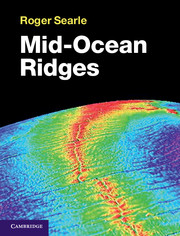Book contents
- Frontmatter
- Dedication
- Contents
- Preface
- 1 Introduction
- 2 Techniques of MOR study: a brief historical review
- 3 The oceanic lithosphere
- 4 Ridges as plate boundaries
- 5 Crustal structure and composition
- 6 Volcanism
- 7 Tectonism
- 8 Hydrothermal processes
- 9 Summary and synthesis
- Appendix A Glossary of terms
- Appendix B Directory of named features
- References
- Index
- Plate Section
8 - Hydrothermal processes
Published online by Cambridge University Press: 05 June 2014
- Frontmatter
- Dedication
- Contents
- Preface
- 1 Introduction
- 2 Techniques of MOR study: a brief historical review
- 3 The oceanic lithosphere
- 4 Ridges as plate boundaries
- 5 Crustal structure and composition
- 6 Volcanism
- 7 Tectonism
- 8 Hydrothermal processes
- 9 Summary and synthesis
- Appendix A Glossary of terms
- Appendix B Directory of named features
- References
- Index
- Plate Section
Summary
Introduction
Newly formed oceanic lithosphere is extensively fissured and faulted (Chapter 7), providing pathways for seawater to penetrate the crust. As it does so, it can become heated by hot rocks at depth, producing a highly chemically reactive fluid that undergoes significant exchange of elements with the host rocks. The heated fluid is sufficiently buoyant to return to the sea floor and emerge in ‘hydrothermal vents’. Such vents may be concentrated into narrow jets, or broadly distributed as diffuse emanations. The debouching fluids range from just above ambient temperature (~2 °C) to >400 °C, and have a wide range of chemical properties. They may be acid or alkali, have salinities higher or lower than seawater, and carry a wide and variable range of dissolved minerals that they may precipitate onto the sea floor. Dissolved elements include Ca, Fe, Mn, Zn, Ni, Cu and Au and a range of gases including H2, He, CO2 and CH4. They may produce large, potentially economically important mineral deposits, and influence the chemistry of seawater in important ways. Hydrothermal vents carry approximately one third of the global oceanic heat flux and 25% of the global crustal heat flux (Sclater et al., 1981; Morton and Sleep, 1985; Stein and Stein, 1994). To dissipate this amount of heat, ~5 × 1014 kg of seawater must pass through MOR hydrothermal systems every year (Wolery and Sleep, 1976). Hydrothermal vents host unique faunal assemblages based on extremophile chemotrophic micro-organisms, which in turn support a range of specialised filter feeders and predator species. Reviews of hydrothermal systems include edited volumes by Rona et al. (1983), Humphris et al. (1995), German et al. (2004) and Rona et al. (2010).
Discovery and distribution of hydrothermal vents
Early in the development of sea floor spreading theory, Bostrom et al. (1969) noted very low aluminium and titanium and high iron and manganese contents in sediments from active MORs, and suggested that such ridges contain a source of ‘volcanic emanations’ containing Fe and Mn that subsequently mix with ocean bottom waters. Measured conductive heat flow in ocean basins younger than ~60 Ma is less than predicted by plate theory (Section 3.2). Based on such observations, Lister (1972) suggested the dominant heat transfer process at ridge crests is hydrothermal circulation.
- Type
- Chapter
- Information
- Mid-Ocean Ridges , pp. 200 - 230Publisher: Cambridge University PressPrint publication year: 2013



